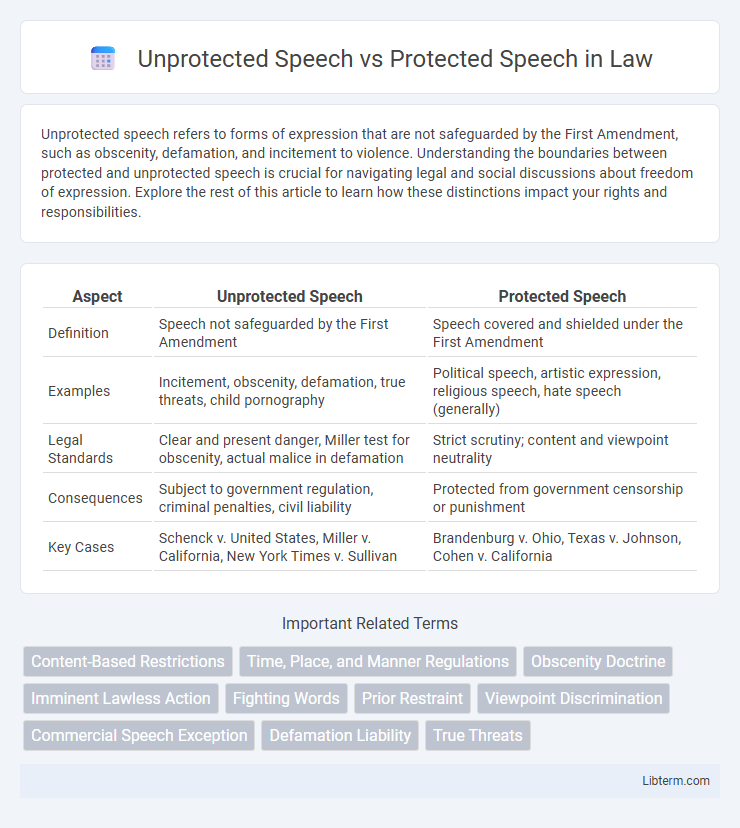Unprotected speech refers to forms of expression that are not safeguarded by the First Amendment, such as obscenity, defamation, and incitement to violence. Understanding the boundaries between protected and unprotected speech is crucial for navigating legal and social discussions about freedom of expression. Explore the rest of this article to learn how these distinctions impact your rights and responsibilities.
Table of Comparison
| Aspect | Unprotected Speech | Protected Speech |
|---|---|---|
| Definition | Speech not safeguarded by the First Amendment | Speech covered and shielded under the First Amendment |
| Examples | Incitement, obscenity, defamation, true threats, child pornography | Political speech, artistic expression, religious speech, hate speech (generally) |
| Legal Standards | Clear and present danger, Miller test for obscenity, actual malice in defamation | Strict scrutiny; content and viewpoint neutrality |
| Consequences | Subject to government regulation, criminal penalties, civil liability | Protected from government censorship or punishment |
| Key Cases | Schenck v. United States, Miller v. California, New York Times v. Sullivan | Brandenburg v. Ohio, Texas v. Johnson, Cohen v. California |
Understanding the First Amendment: An Overview
Unprotected speech includes categories such as incitement to imminent lawless action, obscenity, defamation, and true threats, which do not receive First Amendment protection due to their potential harm. Protected speech encompasses political speech, artistic expression, and symbolic speech, all safeguarded to preserve free discourse under the First Amendment. The First Amendment balances protecting individual expression with maintaining public order by excluding speech that directly causes harm or illegal activities.
What Constitutes Protected Speech?
Protected speech encompasses expressions safeguarded by the First Amendment, including political commentary, artistic works, and symbolic acts that do not incite imminent lawless action. Courts evaluate whether speech falls under protected categories by assessing its content, context, and potential to cause direct harm or disruption. Speech advocating illegal conduct or containing true threats typically loses protection, whereas opinions and ideas--even if controversial--remain constitutionally shielded.
Defining Unprotected Speech under U.S. Law
Unprotected speech under U.S. law includes categories such as obscenity, defamation, incitement to imminent lawless action, and true threats, which do not receive First Amendment protection. The Supreme Court has established tests, such as the Miller test for obscenity and the Brandenburg test for incitement, to delineate these limits. Speech falling into these categories can be regulated or punished without violating constitutional free speech rights.
Key Supreme Court Cases on Protected and Unprotected Speech
The landmark Supreme Court case Brandenburg v. Ohio (1969) established the standard that speech advocating illegal conduct is protected unless it incites imminent lawless action and is likely to produce such action. In Chaplinsky v. New Hampshire (1942), the Court identified unprotected categories including "fighting words" which by their utterance inflict injury or incite immediate breach of peace. The Court further clarified in Tinker v. Des Moines (1969) that symbolic speech is protected under the First Amendment, while obscenity and defamation remain notable exceptions as outlined in Miller v. California (1973) and New York Times Co. v. Sullivan (1964), respectively.
Categories of Unprotected Speech Explained
Unprotected speech includes categories such as incitement to imminent lawless action, true threats, obscenity, child pornography, and speech integral to criminal conduct, which are not safeguarded by the First Amendment. These categories are narrowly defined by the U.S. Supreme Court to prevent harm while balancing free speech rights. Understanding these distinctions helps clarify the legal boundaries where speech loses constitutional protection due to its potential to cause direct harm or violate laws.
The Importance of Context in Free Speech Rights
Unprotected speech, such as incitement to violence or true threats, falls outside First Amendment protections due to its potential harm, whereas protected speech includes expressions upheld even if controversial or offensive. The importance of context lies in distinguishing when speech crosses the line into unprotected categories based on factors like intent, likelihood of causing harm, and setting. Courts analyze context thoroughly to balance free speech rights with public safety and order, ensuring constitutional protections are not misused to justify harmful conduct.
Hate Speech: Where Is the Legal Line Drawn?
Unprotected speech, such as hate speech, crosses the legal line when it incites imminent lawless action or constitutes true threats, lacking First Amendment protection. The Supreme Court's Brandenburg v. Ohio (1969) ruling set a precedent that hate speech is protected unless it is directed to and likely to incite immediate violence or illegal acts. Legal frameworks balance protecting free expression and preventing harm by restricting speech that poses a clear and present danger or targets individuals based on race, religion, or ethnicity with intent to intimidate or incite violence.
Censorship, Free Speech, and Modern Challenges
Unprotected speech, such as incitement to violence, obscenity, and defamation, falls outside the scope of First Amendment protections and is subject to censorship to prevent harm. Protected speech includes political dissent, artistic expression, and controversial opinions, ensuring individuals can challenge power and societal norms without fear of government retribution. Modern challenges to free speech involve balancing digital platform regulations, misinformation control, and hate speech prevention while upholding constitutional rights in an increasingly complex communication landscape.
Impacts of Unprotected Speech on Society
Unprotected speech, including incitement to violence, hate speech, and defamation, often leads to social unrest and harm to targeted groups, undermining community cohesion. The absence of legal protection allows governments to regulate such speech to prevent physical harm and maintain public order. Persistent unprotected speech can erode trust in institutions, fuel discrimination, and contribute to polarization within society.
Navigating the Balance: Free Expression vs. Public Safety
Unprotected speech, including incitement to violence, true threats, and obscenity, is excluded from First Amendment protection to safeguard public safety and maintain social order. Protected speech encompasses expression that does not directly incite harm or illegal activity, preserving individuals' rights to free speech while preventing danger to the community. Navigating this balance requires careful legal scrutiny to ensure restrictions target only speech causing imminent harm without unduly infringing on constitutional freedoms.
Unprotected Speech Infographic

 libterm.com
libterm.com